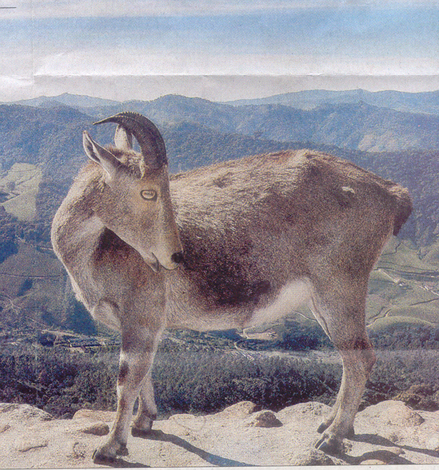ENDANGERED GOAT
-Shivani Thakur
Along the southern parts of Western Ghats a species similar to our domestic goat is found. For all of us to comprehend the importance this species would be difficult. But this is no ordinary goat. This is the Nilgiri Tahr and it is endangered.
The tahr is found in the high ranges of Kerala and Tamil Nadu.They belong to the family Bovidae that includes even- toed, horned antelopes. Its similar counterpart is the Himalayan Tahr and the Arabian Tahr.
 The tahr is considered the primitive cousin of true goats. They posses certain characteristics of primitive goats-antelopes such as similarity of horn size in both male and females and certain other features that characterize true goats such as striking
coat color, difference between the sexes and presence of odoriferous glands. Probably their this vulnerability is responsible for their diminishing numbers.
The tahr is considered the primitive cousin of true goats. They posses certain characteristics of primitive goats-antelopes such as similarity of horn size in both male and females and certain other features that characterize true goats such as striking
coat color, difference between the sexes and presence of odoriferous glands. Probably their this vulnerability is responsible for their diminishing numbers.
The tahr is mainly found in the Eravikulam National Park near Munnar in Kerala. The 97 sq km park situated at an altitude of 1,400 to 2,695 meters along the Kerala –Tamil Nadu border is its abode.
The distinctive features are its brown coat with dark brown band running down the center of the back and a lighter white colored chest, belly and throat. The horns are 40cms in males and 30 cms in females. They generally have small herds grazing during the
day and resting in the night. Male tahrs are known to fight during the mating season or over the territory.
In spite of being in the protective land their population has suffered. From 1,008 in the year 1997to merely 600 in 2002. They prefer open terrains, cliffs and grass covered hills. In 2004 the park was ravaged by a forest fire resulting in inadequate supply
of food for them. But in 2005 good rainfall and effective steps taken by the authorities helped in increasing their population. They also face threat from predators like tigers, wild dogs, leopards and jackals.
The tahr might not be considered one of the many species to have a direct effect on our environment but conservation of large bodied vertebrates and other forms of flora and fauna are more prone to extinction as their resilience to human induced disturbances
are directly proportionate to the extent of the habitat and food sources available.
There are many views regarding the sustainable use of resources. This ideology basically advocates opening up of forests resources to local communities for harvesting. But this sustainable use can change into over exploitation. classic example is the high
extraction of fruits from Myristica spp and Garcinia spp of trees in the swamps in the Western Ghats. Although the tahr is a species still not majorily affected by human intervention because of its obscurity and the fact that little information is widely available.
Yet due to its loss of habitat and many predators, there is need to be aware of the threat it can face if its habitat is opened up.
It is a widely known fact that nature has a way of balancing itself if left to its own devices. Maybe we should start looking at the tahr as no ordinary goat but part of our rich bio-diversity.
( Photograph of Nilgiri Tahr by by K.K Mustafah from an article which appeared in The Hindu dated January 16, 2005)